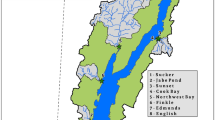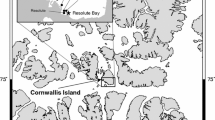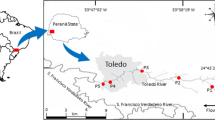Abstract
Macroinvertebrates are a key vector in the transfer of methylmercury (MeHg) to fish. However, the factors that affect MeHg concentrations and bioaccumulation in these organisms are not as well understood as for fish, and studies on a broad geographic scale are lacking. In this study, we gathered published and unpublished MeHg and carbon (δ13C) and nitrogen (δ15N) stable isotope data for freshwater macroinvertebrates from 119 lakes and wetlands across seven Canadian provinces, along with selected physical, chemical and biological characteristics of these systems. Overall, water pH was the most important determinant of MeHg concentrations in both predatory and non-predatory invertebrates [\( {\text{R}}^{2}_{\text{adj}} \) = 0.32, p < 0.001; multivariate canonical redundancy analysis (RDA)]. The location of lakes explained additional variation in invertebrate MeHg (partial R2 = 0.08 and 0.06 for latitude and longitude, respectively; RDA), with higher concentrations in more easterly and southerly regions. Both invertebrate foraging behaviour and trophic position (indicated by functional feeding groups and δ15N values, respectively) also predicted MeHg concentrations in the organisms. Collectively, results indicate that in addition to their feeding ecology, invertebrates accumulate more MeHg in acidic systems where the supply of MeHg to the food web is typically high. MeHg concentrations in macroinvertebrates may also be influenced by larger-scale geographic differences in atmospheric mercury deposition among regions.






Similar content being viewed by others
References
Allen EW, Prepas EE, Gabos S, Strachan WMJ, Zhang WP (2005) Methyl mercury concentrations in macroinvertebrates and fish from burned and undisturbed lakes on the boreal plain. Can J Fish Aquat Sci 62:1963–1977
Anderson C, Cabana G (2007) Estimating the trophic position of aquatic consumers in river food webs using stable nitrogen isotopes. J N Am Benthol Soc 262:273–285
Barbour MT, Gerritsen J, Snyder BD, Stribling JB (1999) Rapid bioassessment protocols for use in streams and wadeable rivers: Periphyton, benthic macroinvertebrates and fish, 2nd edn. Environmental Protection Agency, Washington, DC
Bates LM, Hall BD (2012) Investigating the concentrations of methylmercury in invertebrates from Saskatchewan Prairie Pothole Wetlands. Environ Pollut 160:153–160
Bodaly RA, Rudd JWM, Fudge RJP, Kelly CA (1993) Mercury concentrations in fish related to size of remote Canadian Shield lakes. Can J Fish Aquat Sci 50:980–987
Bunn SE, Leigh S, Jardine TD (2013) Diet-tissue fractionation of 15 N by freshwater consumers and the importance of algae in stream and river food webs. Limnol Oceanogr 58:765–773
Burnham KP, Anderson DR (2002) Model selection and multi-model inference: a practical information-theoretic approach, 2nd edn. Springer, New York
Cabana G, Rasmussen J (1996) Comparison of aquatic food chains using nitrogen isotopes. Proc Natl Acad Sci USA 93:10844–10847
Chasar LC, Scudder BC, Stewart AR, Bell AH, Aiken GR (2009) Mercury cycling in stream ecosystems. 3. Trophic dynamics and methylmercury bioaccumulation. Environ Sci Technol 43:2733–2739
Chételat J, Amyot M, Garcia E (2011) Habitat-specific bioaccumulation of methylmercury in invertebrates of small mid-latitude lakes in North America. Environ Pollut 1591:10–17
Clair TA, Dennis IF, Scruton DA, Gilliss M (2007) Freshwater acidification research in Atlantic Canada: a review of results and predictions for the future. Environ Rev 15:153–167
Clair TA, Dennis IF, Vet R, Laudon H (2008) Long-term trends in catchment organic carbon and nitrogen exports from three acidified catchments in Nova Scotia, Canada. Biogeochemical 87:83–97
Clayden MG, Kidd KA, Wyn B, Kirk JL, Muir DCG, O’Driscoll NJ (2013) Mercury biomagnification through food webs is affected by physical and chemical characteristics of lakes. Environ Sci Technol 47(21):12047–12053. doi:10.1021/es4022975
Cremona F, Planas D, Lucotte M (2008) Assessing the importance of macroinvertebrate trophic dead ends in the lower transfer of methylmercury in littoral food webs. Can J Fish Aquat Sci 65(9):2043–2052
Cremona F, Hamelin S, Planas D, Lucotte M (2009) Sources of organic matter and methylmercury in littoral macroinvertebrates: a stable isotope approach. Biogeochemical 94:81–94
Daguené V, McFall E, Yumvihoze E, Xiang S, Amyot M, Poulain AJ (2012) Divalent base cations hamper Hg-II uptake. Environ Sci Technol 46:6645–6653
Dastoor A, Larocque Y (2004) Global circulation of atmospheric mercury: a modelling study. Atmospher Environ 38:147–161
de la Cruz AA (1979) Production and transport of detritus in wetlands. In: Greeson PE, Clark JR, Clark JE (eds) Wetland functions and values: the state of our understanding. American Water Resources Association, Minneapolis
Depew DC, Burgess NM, Anderson MR, Baker R, Bhavsar SP, Bodaly RA, Eckley CS, Evans MS, Gantner N, Graydon JA, Jacobs K, Leblanc JE, St. Louis VL, Campbell LM (2013) An overview of mercury concentrations in freshwater fish species: a national fish mercury dataset for Canada. Can J Fish Aquat Sci 70:436–451
Driscoll CT, Blette V, Yan C, Schofield CL, Munson R, Holsapple J (1995) The role of dissolved organic-carbon in the chemistry and bioavailability of mercury in remote Adirondack lakes. Water Air Soil Pollut 80:499–508
Florin ST, Felicetti LA, Robbins CT (2011) The biological basis for understanding and predicting dietary-induced variation in nitrogen and sulphur isotope ratio discrimination. Funct Ecol 25:519–526
Hall BD, Bodaly RA, Fudge RJP, Rudd JWM, Rosenberg DM (1997) Food as the dominant pathway of methylmercury uptake by fish. Water Air Soil Pollut 100:13–24
Hall BD, Rosenberg DM, Wiens AP (1998) Methyl mercury in aquatic insects from an experimental reservoir. Can J Fish Aquat Sci 55:2036–2047
Hall BD, Aiken GR, Krabbenhoft DP, Marvin-Dipasquale M, Swarzenski CM (2008) Wetlands as principal zones of methylmercury production in Southern Louisiana and the Gulf of Mexico region. Environ Pollut 154:124–134
Harding KM, Gowland JA, Dillon PJ (2006) Mercury concentration in black flies Simulium spp. (Diptera, Simuliidae) from soft-water streams in Ontario, Canada. Environ Pollut 143:529–535
Haro RJ, Bailey SW, Northwick RM, Rolfhus KR, Sandheinrich MB, Weiner JG (2013) Burrowing dragonfly larvae as biosentinels of methylmercury in freshwater food webs. Environ Sci Technol 47:8148–8156
Hecky RE, Hesslein RH (1995) Contributions of benthic algae to lake food webs as revealed by stable isotope analysis. J N Am Benthol Soc 14:631–653
Holm S (1979) A simple sequentially rejective multiple test procedure. Scand J Stat 6:65–70
Hrenchuk LE, Blanchfield PJ, Paterson MJ, Hintelmann HH (2012) Dietary and waterborne mercury accumulation by yellow perch: a field experiment. Environ Sci Technol 46:509–516
Jardine TD, Kidd KA, Fisk AT (2006) Applications, considerations, and sources of uncertainty when using stable isotope analysis in ecotoxicology. Environ Sci Technol 40:7501–7511
Jardine TD, Kidd KA, Rasmussen JB (2012) Aquatic and terrestrial organic matter in the diet of stream consumers: implications for mercury bioaccumulation. Ecol Appl 22:843–855
Jardine TD, Kidd KA, O’Driscoll N (2013) Food web analysis reveals effects of pH on mercury bioaccumulation at multiple trophic levels in streams. Aquat Toxicol 132–133:46–52
Kamman NC, Burgess NM, Driscoll CT, Simonin HA, Goodale W, Linehan J, Estabrook R, Hutcheson M, Major A, Scheuhammer AM, Scruton DA (2005) Mercury in freshwater fish of northeast North America: a geographic perspective based on fish tissue monitoring databases. Ecotoxicology 14:163–180
Kelly CA, Rudd JWM, Holoka MH (2003) Effect of pH on mercury uptake in an aquatic bacterium: implications for Hg cycling. Environ Sci Technol 37:2941–2946
Kidd KA, Paterson MJ, Hesslein RH, Muir DCG, Hecky RE (1999) Effects of northern pike (Esox lucius) additions on pollutant accumulation and food web structure, as determined by delta C-13 and delta N-15, in a eutrophic and an oligotrophic lake. Can J Fish Aquat Sci 56:2193–2202
Kidd KA, Clayden MG, Jardine TD (2012a) Bioaccumulation and biomagnification of mercury in food webs. In: Liu G, Cai Y, O’Driscoll NJ (eds) Environmental chemistry and toxicology of mercury. Wiley, Hoboken, pp 455–499
Kidd KA, Muir DCG, Evans MS, Wang X, Whittle M, Swanson HK, Johnston T, Guildford S (2012b) Biomagnification of mercury through lake trout food webs with different physical, chemical and biological characteristics. Sci Total Environ 438:135–143
Mason RP, Laporte JM, Andres S (2000) Factors controlling the bioaccumulation of mercury, methylmercury, arsenic, selenium, and cadmium by freshwater invertebrates and fish. Archiv Environ Toxicol Chem 38:283–297
McCutchan JH, Lewis WM, Kendall C, McGrath CC (2003) Variation in trophic shift for stable isotope ratios of carbon, nitrogen, and sulfur. Oikos 102:378–390
Merritt RW, Cummins KW (1996) An introduction to the aquatic insects of North America, 3rd edn. Kendall-Hunt, Dubuque
Molina CI, Gibon FM, Duprey JL, Dominguez E, Guimaraes JRD, Roulet M (2010) Transfer of mercury and methylmercury along macroinvertebrate food chains in a floodplain lake of the Beni River, Bolivian Amazonia. Sci Total Environ 408:3382–3391
Muir DCG, Wang X, Yang F, Nguyen N, Jackson TA, Evans MS, Douglas M, Koeck G, Lamoureux S, Pienitz R, Smol JP, Vincent WF, Dastoor A (2009) Spatial trends and historical deposition of mercury in eastern and northern Canada inferred from lake sediment cores. Environ Sci Technol 43:4802–4809
Munthe J, Bodaly RA, Branfireun BA, Driscoll CT, Gilmour CC, Harris R, Horvat M, Lucotte M, Malm O (2007) Recovery of mercury-contaminated fisheries. Ambio 36:33–44
Murkin HR (1989) The basis for food chains in prairie wetlands. In: Van der Valk AG (ed) Northern prairie wetlands. Iowa State University Press, Ames, pp 316–338
Pickhardt PC, Folt CL, Chen CY, Klaue B, Blum JD (2002) Algal blooms reduce the uptake of toxic methylmercury in freshwater food webs. Proc Natl Acad Sci USA 99(7):4419–4423
Rennie MD, Collins NC, Purchase CF, Tremblay A (2005) Predictive models of benthic invertebrate methylmercury in Ontario and Quebec lakes. Can J Fish Aquat Sci 62:2770–2783
Rimmer CC, McFarland KP, Evers DC, Miller EK, Aubry Y, Busby D, Taylor RJ (2005) Mercury concentrations in Bicknell’s thrush and other insectivorous passerines in montane forests of northeastern North America. Ecotoxicology 14:223–240
Riscassi AL, Scanlon TM (2011) Controls on stream water dissolved mercury in three mid-Appalachian forested headwater catchments. Water Resour Res 47:W12512. doi:10.1029/2011WR010977
Riva-Murray K, Chasar LC, Bradley PM, Burns DA, Brigham ME, Smith MJ, Abrahamsen TA (2011) Spatial patterns of mercury in macroinvertebrates and fishes from streams of two contrasting forested landscapes in the eastern United States. Ecotoxicology 20:1530–1542
Riva-Murray K, Bradley PM, Chasar LC, Button DT, Brigham ME, Scudder Eikenberry BC, Journey CA, Lutz MA (2013) Influence of dietary carbon on mercury bioaccumulation in streams of the Adirondack Mountains of New York and the Coastal Plain of South Carolina, USA. Ecotoxicology 22:60–71
Rolfhus KR, Hall BD, Monson BA, Paterson MJ, Jeremiason JD (2011) Assessment of mercury bioaccumulation within the pelagic food web of lakes in the western Great Lakes region. Ecotoxicology 20:1520–1529
Sarica J, Amyot A, Hare L, Doyon MR, Stanfield LW (2004) Salmon-derived mercury and nutrients in a Lake Ontario spawning stream. Limnol Oceanogr 49:891–899
Spry DJ, Wiener JG (1991) Metal bioavailability and toxicity to fish in low-alkalinity lakes: a critical review. Environ Poll 71:243–304
Tremblay A, Lucotte M (1997) Accumulation of total mercury and methyl mercury in insect larvae of hydroelectric reservoirs. Can J Fish Aquat Sci 54(832):841
Tsui MTK, Finlay JC (2011) Influence of dissolved organic carbon on methylmercury bioavailability across Minnesota stream ecosystems. Environ Sci Technol 45:5981–5987
Tsui MTK, Finlay JC, Nater EA (2009) Mercury bioaccumulation in a stream network. Environ Sci Technol 43:7016–7022
Ullrich SM, Tanton TW, Abdrashitova SA (2001) Mercury in the aquatic environment: a review of factors affecting methylation. Crit Rev Environ Sci Technol 31:241–293
Watras CJ, Back RC, Halvorsen S, Hudson RJM, Morrison KA, Wente SP (1998) Bioaccumulation of mercury in pelagic freshwater food webs. Sci Total Environ 219:183–208
Wyn B, Kidd KA, Burgess NM, Curry RA (2009) Mercury biomagnification in the food webs of acidic lakes in Kejimkujik National Park and National Historic Site, Nova Scotia. Can J Fish Aquat Sci 66:1532–1545
Acknowledgments
Funding for this research was provided by Environment Canada’s Clean Air Regulatory Agenda (CARA) and the Natural Sciences and Engineering Research Council of Canada (NSERC).
Conflict of interest
The authors declare that they have no conflict of interest.
Author information
Authors and Affiliations
Corresponding author
Electronic supplementary material
Below is the link to the electronic supplementary material.
Rights and permissions
About this article
Cite this article
Clayden, M.G., Kidd, K.A., Chételat, J. et al. Environmental, geographic and trophic influences on methylmercury concentrations in macroinvertebrates from lakes and wetlands across Canada. Ecotoxicology 23, 273–284 (2014). https://doi.org/10.1007/s10646-013-1171-9
Accepted:
Published:
Issue Date:
DOI: https://doi.org/10.1007/s10646-013-1171-9




